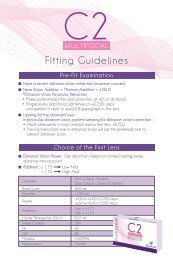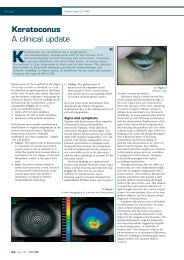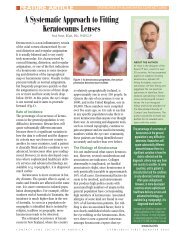irregular cornea - David Thomas Contact Lenses
irregular cornea - David Thomas Contact Lenses
irregular cornea - David Thomas Contact Lenses
You also want an ePaper? Increase the reach of your titles
YUMPU automatically turns print PDFs into web optimized ePapers that Google loves.
<strong>David</strong> <strong>Thomas</strong> <strong>Contact</strong> <strong>Lenses</strong> now offer a solution to fitting the<br />
Irregular Cornea successfully - the Rose K IC lens<br />
With increased practitioner interest and the availability of modern instrument technology such as <strong>cornea</strong>l<br />
topographers, the <strong>irregular</strong> <strong>cornea</strong> is no longer the difficult challenge it used to be. <strong>David</strong> <strong>Thomas</strong> <strong>Contact</strong><br />
<strong>Lenses</strong> have now helped bring the fitting of <strong>irregular</strong> <strong>cornea</strong> with specialist lenses into the hands of any<br />
contact lens practitioner. Through investment in the latest lathing and oscillating tool technology and now<br />
the introduction of the Rose K IC lens design, <strong>David</strong> <strong>Thomas</strong> <strong>Contact</strong> <strong>Lenses</strong> can offer the practitioner a<br />
solution to fitting even the most difficult cases with a high degree of success.<br />
Rose K IC Indications<br />
The Rose K IC contact lens for <strong>irregular</strong> <strong>cornea</strong>s is a large diameter GP lens which opens up an extended<br />
range of applications such as Pellucid marginal Degeneration (PMD), Keratoglobus, Post Graft, and LASIK<br />
Induced Ecstasia with secondary applications for Nipple and Oval cones.<br />
Pellucid Marginal Degeneration (PMD)<br />
PMD is a bilateral <strong>cornea</strong>l disorder hallmarked by a thinning of the inferior peripheral <strong>cornea</strong> typically 1 to<br />
2mm above the inferior limbus (figure 1). It is usually restricted to the 4-8 o’clock region. The <strong>cornea</strong> will<br />
exhibit a flat area just inside this region before steepening rapidly as the <strong>cornea</strong> thins and is characterised<br />
by large degrees of central against the rule astigmatism (figure 2). Topography maps often show a pattern<br />
‘likened to two birds kissing’.<br />
Figure 1 - Pellucid Marginal Degeneration<br />
(Courtesy of Pat Caroline)<br />
Figure 2 - PMD with high ATR astigmatism<br />
(Courtesy of Pat Caroline)<br />
Keratoglobus<br />
In instances of globus cones where a large area of the <strong>cornea</strong> is affected of which up to 75% is below the<br />
visual axis, then Munson's sign is usually present. This is where there is forward displacement of the lower<br />
lid by the cone on downward gaze.<br />
Post Graft<br />
Where patients have undergone penetrating keratoplasty or a <strong>cornea</strong>l graft, then the Rose K IC lens is<br />
useful to aid postoperative recovery and improve vision. In these cases a large diameter lens is preferable<br />
to bridge the graft and host/donor junction. Expect to see significant toricity in most grafts.<br />
LASIK induced ecstasia<br />
Lasik procedure can occasionally lead to complications such as Lasik Induced Ecstasia. This causes an<br />
outward bulging of the <strong>cornea</strong> resulting in <strong>irregular</strong> astigmatism and poor vision and usually happens when<br />
the <strong>cornea</strong> is not thick enough to leave an adequate stromal bed following Lasik treatment.
















